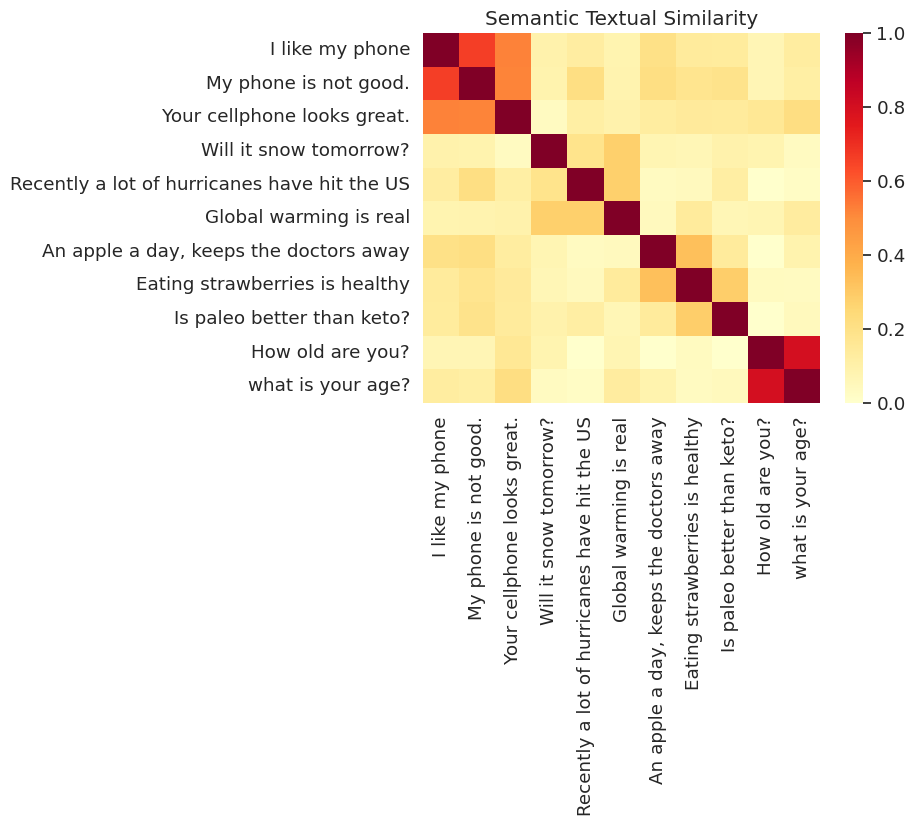 Zobacz na TensorFlow.org Zobacz na TensorFlow.org |  Uruchom w Google Colab Uruchom w Google Colab |  Zobacz na GitHub Zobacz na GitHub |  Pobierz notatnik Pobierz notatnik |  Zobacz modele piasty TF Zobacz modele piasty TF |
Ten notatnik ilustruje, jak uzyskać dostęp do Universal Sentence Encoder i używać go do zadań związanych z podobieństwem zdań i klasyfikacją zdań.
Universal Sentence Encoder sprawia, że uzyskiwanie osadzeń na poziomie zdań jest tak łatwe, jak dawniej wyszukiwanie osadzeń dla poszczególnych słów. Osadzania zdań można następnie w trywialny sposób wykorzystać do obliczenia podobieństwa na poziomie zdań, a także w celu umożliwienia lepszej wydajności w dalszych zadaniach klasyfikacyjnych przy użyciu mniej nadzorowanych danych treningowych.
Ustawiać
Ta sekcja konfiguruje środowisko dostępu do Universal Sentence Encoder w TF Hub i zawiera przykłady zastosowania kodera do słów, zdań i akapitów.
%%capture
!pip3 install seaborn
Więcej szczegółowych informacji na temat instalowania Tensorflow można znaleźć na https://www.tensorflow.org/install/ .
Załaduj moduł TF Hub Universal Sentence Encoder
from absl import logging
import tensorflow as tf
import tensorflow_hub as hub
import matplotlib.pyplot as plt
import numpy as np
import os
import pandas as pd
import re
import seaborn as sns
module_url = "https://tfhub.dev/google/universal-sentence-encoder/4"
model = hub.load(module_url)
print ("module %s loaded" % module_url)
def embed(input):
return model(input)
module https://tfhub.dev/google/universal-sentence-encoder/4 loaded
Oblicz reprezentację dla każdej wiadomości, pokazując różne obsługiwane długości.
word = "Elephant"
sentence = "I am a sentence for which I would like to get its embedding."
paragraph = (
"Universal Sentence Encoder embeddings also support short paragraphs. "
"There is no hard limit on how long the paragraph is. Roughly, the longer "
"the more 'diluted' the embedding will be.")
messages = [word, sentence, paragraph]
# Reduce logging output.
logging.set_verbosity(logging.ERROR)
message_embeddings = embed(messages)
for i, message_embedding in enumerate(np.array(message_embeddings).tolist()):
print("Message: {}".format(messages[i]))
print("Embedding size: {}".format(len(message_embedding)))
message_embedding_snippet = ", ".join(
(str(x) for x in message_embedding[:3]))
print("Embedding: [{}, ...]\n".format(message_embedding_snippet))
Message: Elephant Embedding size: 512 Embedding: [0.008344474248588085, 0.00048079612315632403, 0.06595245748758316, ...] Message: I am a sentence for which I would like to get its embedding. Embedding size: 512 Embedding: [0.05080860108137131, -0.016524313017725945, 0.015737781301140785, ...] Message: Universal Sentence Encoder embeddings also support short paragraphs. There is no hard limit on how long the paragraph is. Roughly, the longer the more 'diluted' the embedding will be. Embedding size: 512 Embedding: [-0.028332678601145744, -0.05586216226220131, -0.012941479682922363, ...]
Przykład zadania semantycznego podobieństwa tekstu
Osadzenia tworzone przez Universal Sentence Encoder są w przybliżeniu znormalizowane. Podobieństwo semantyczne dwóch zdań można w trywialny sposób obliczyć jako produkt wewnętrzny kodowań.
def plot_similarity(labels, features, rotation):
corr = np.inner(features, features)
sns.set(font_scale=1.2)
g = sns.heatmap(
corr,
xticklabels=labels,
yticklabels=labels,
vmin=0,
vmax=1,
cmap="YlOrRd")
g.set_xticklabels(labels, rotation=rotation)
g.set_title("Semantic Textual Similarity")
def run_and_plot(messages_):
message_embeddings_ = embed(messages_)
plot_similarity(messages_, message_embeddings_, 90)
Wizualizacja podobieństwa
Tutaj pokazujemy podobieństwo na mapie cieplnej. Końcowa wykres jest macierz 9x9, gdzie każdy wpis [i, j] jest zabarwiona na podstawie wewnętrznego produktu z kodowaniem dla zdaniu i i j .
messages = [
# Smartphones
"I like my phone",
"My phone is not good.",
"Your cellphone looks great.",
# Weather
"Will it snow tomorrow?",
"Recently a lot of hurricanes have hit the US",
"Global warming is real",
# Food and health
"An apple a day, keeps the doctors away",
"Eating strawberries is healthy",
"Is paleo better than keto?",
# Asking about age
"How old are you?",
"what is your age?",
]
run_and_plot(messages)

Ocena: test porównawczy STS (Semantyczne podobieństwo tekstu)
Benchmark STS zapewnia wewnętrzną ocenę, w jakim stopniu wyniki obliczone z wykorzystaniem podobieństwa zdanie zanurzeń align z orzeczeń człowieka. Benchmark wymaga, aby systemy zwracały wyniki podobieństwa dla zróżnicowanego doboru par zdań. Pearson korelacji są następnie wykorzystywane do oceny jakości wyników maszyna podobieństwa wobec orzeczeń człowieka.
Pobierz dane
import pandas
import scipy
import math
import csv
sts_dataset = tf.keras.utils.get_file(
fname="Stsbenchmark.tar.gz",
origin="http://ixa2.si.ehu.es/stswiki/images/4/48/Stsbenchmark.tar.gz",
extract=True)
sts_dev = pandas.read_table(
os.path.join(os.path.dirname(sts_dataset), "stsbenchmark", "sts-dev.csv"),
error_bad_lines=False,
skip_blank_lines=True,
usecols=[4, 5, 6],
names=["sim", "sent_1", "sent_2"])
sts_test = pandas.read_table(
os.path.join(
os.path.dirname(sts_dataset), "stsbenchmark", "sts-test.csv"),
error_bad_lines=False,
quoting=csv.QUOTE_NONE,
skip_blank_lines=True,
usecols=[4, 5, 6],
names=["sim", "sent_1", "sent_2"])
# cleanup some NaN values in sts_dev
sts_dev = sts_dev[[isinstance(s, str) for s in sts_dev['sent_2']]]
/tmpfs/src/tf_docs_env/lib/python3.7/site-packages/IPython/core/interactiveshell.py:3444: FutureWarning: The error_bad_lines argument has been deprecated and will be removed in a future version. exec(code_obj, self.user_global_ns, self.user_ns)
Oceń osadzania zdań
sts_data = sts_dev
def run_sts_benchmark(batch):
sts_encode1 = tf.nn.l2_normalize(embed(tf.constant(batch['sent_1'].tolist())), axis=1)
sts_encode2 = tf.nn.l2_normalize(embed(tf.constant(batch['sent_2'].tolist())), axis=1)
cosine_similarities = tf.reduce_sum(tf.multiply(sts_encode1, sts_encode2), axis=1)
clip_cosine_similarities = tf.clip_by_value(cosine_similarities, -1.0, 1.0)
scores = 1.0 - tf.acos(clip_cosine_similarities) / math.pi
"""Returns the similarity scores"""
return scores
dev_scores = sts_data['sim'].tolist()
scores = []
for batch in np.array_split(sts_data, 10):
scores.extend(run_sts_benchmark(batch))
pearson_correlation = scipy.stats.pearsonr(scores, dev_scores)
print('Pearson correlation coefficient = {0}\np-value = {1}'.format(
pearson_correlation[0], pearson_correlation[1]))
Pearson correlation coefficient = 0.8036394630692778 p-value = 0.0

